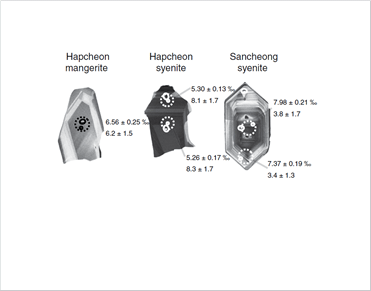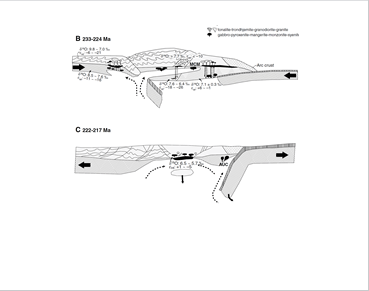Representative Research Publications
Magmatic response to the Triassic orogenies on the Korean Peninsula: Geochronological, geochemical, 2019 > Representative Research Publications > Research Results Home
Magmatic response to the Triassic orogenies on the Korean Peninsula: Geochronological, geochemical, and O-Hf isotopic constraints
- Geological Society of America Bulletin / March 2019
- Chang-sik Cheong (1st & corresponding author)
Study Summary
Widespread Mesozoic plutons in the Korean Peninsula provide first-hand information about the magmatic response to the continental and oceanic plate subduction. This study addresses this issue using comprehensive whole-rock geochemical, zircon U-Pb geochronological, and O-Hf isotopic data obtained from Triassic gabbro-pyroxenite-mangerite-monzonite-syenite-granodiorite-granite plutons in the central and southern parts of the peninsula.
The intrusion of ca. 265–250 Ma calc-alkaline granitoids, including the high-silica adakite, along the outboard (in present coordinates) Yeongnam Massif is coeval with or slightly younger than the Barrovian metamorphism recognized in fold-and-thrust belts surrounding the inboard (northward, present coordinates) Gyeonggi Massif, suggesting a close link between the collisional orogenesis and subduction initiation as commonly documented in Phanerozoic supercontinents. Subsequent Late Triassic plutons emplaced in the Yeongnam Massif are subdivided into the older (232–224 Ma) magnesian and alkali-calcic to calc-alkalic group and the younger (220–217 Ma) ferroan and alkalic to alkali-calcic group temporally intervened by geochemically arc-like Andong ultramafic complex (222 Ma). Zircon O-Hf isotopic compositions of the older plutons reflect the mixing of metasomatized lithospheric mantle, young (probably Paleozoic) arc crust, and Precambrian basement crust, whereas those of the younger plutons reflect input of the asthenospheric/lithospheric mantle and mafic lower crust.
Meanwhile, the Late Triassic (233–224 Ma) potassic plutons in and around the Gyeonggi Massif represent post-collisional magmatism most likely induced by slab breakoff, which may also have been responsible for the shoshonitic magmatism in the Yeongnam Massif. Spatial differences in the age pattern and O-Hf isotopic signature of inherited and synmagmatic zircons from the potassic plutons indicate a selective contribution from an ancient metasomatized lithospheric mantle beneath the North China-like craton and an allochthonous South China-like lithosphere. The formation of the Triassic plutons could be explained by a series of tectonomagmatic events consisting sequentially of the ridge subduction, low-angle subduction, slab breakoff beneath the collisional orogen, tectonic switch to an extension-dominated arc system, and delamination of an overthickened arc lithosphere.
 Figure 1. Representative cathodoluminescence images of zircon grains from the Triassic plutons in the Korean Peninsula. The scale is referenced by Hf isotope spot (large dotted circle, diameter = 50 μm).
Figure 1. Representative cathodoluminescence images of zircon grains from the Triassic plutons in the Korean Peninsula. The scale is referenced by Hf isotope spot (large dotted circle, diameter = 50 μm). Figure 2. Schematic cartoons summarizing the Triassic tectonomagmatic evolution of the Korean Peninsula, with oxygen and hafnium isotopic compositions of mantle and crustal reservoirs.
Figure 2. Schematic cartoons summarizing the Triassic tectonomagmatic evolution of the Korean Peninsula, with oxygen and hafnium isotopic compositions of mantle and crustal reservoirs.
Expected Effects
Geochronological, geochemical, and O-Hf isotopic data, obtained by using the sensitive high-resolution ion microprobe, laser ablation MC-ICPMS, and high-resolution SIMS, collectively indicate that during the Triassic, the Korean Peninsula experienced complex tectonomagmatic events consisting of: 1) ridge subduction and generation of high silica adakite and sodic granitoids along the margin of the Yeongnam Massif (~250 Ma), 2) development of an advancing arc system and magmatic quiescence, 3) post-collisional slab breakoff and consequent potassic/ultrapotassic magmatism in and around the Gyeonggi Massif and shoshonitic magmatism in the Yeongnam Massif (~230 Ma), 4) inland migration of arc magmatism until 224 Ma, and 5) tectonic switch to the extension-dominated arc system and delamination of an overthickened arc lithosphere that resulted in the formation of the ferroan plutons in the Yeongnam Massif (222–217 Ma).
ㅇ DOI : https://doi.org/10.1130/B32021.1



